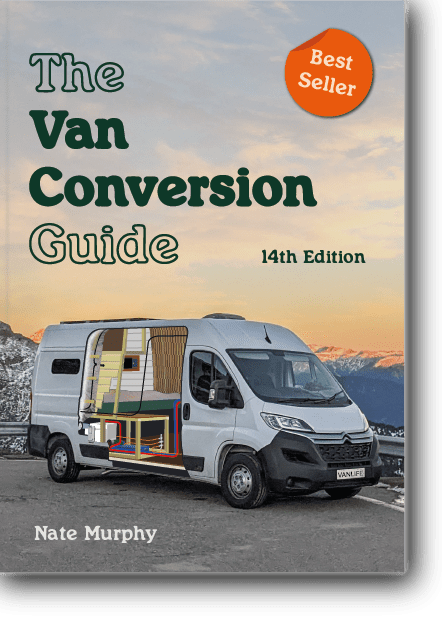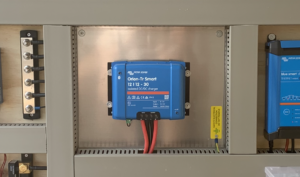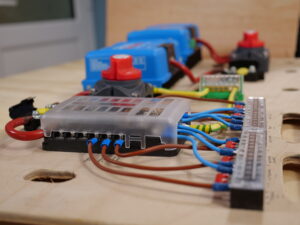How To Build A Campervan Water System
last updated: Mar 22, 2022
One of the most important aspects of living in a van is having clean, safe, and consistent access to water.
This means installing a campervan water system.
You’ll need water for drinking, showers, washing dishes and clothes, cooking and more! Having a proper water system in your campervan can make all the difference when it comes to vanlife.
There are many different ways to go about installing a campervan water system. From a minimal, easy, weekend setup- to a behemoth, off-road and off-grid water setup.
We’ve taken some of our favorite campervan water systems that we’ve seen and broken them down for you into a simple, all inclusive campervan water system guide.
Once you’ve read through this guide and decided on your dream campervan water system, feel free to dive into my Van Conversion Guide where I give detailed step-by-step instructions on how to not only install your campervan water system, but also how to design your entire campervan.
Let’s jump right in!
Part 1: Important Campervan Water System Considerations
Before jumping right in and installing your campervan system, you’ll really want to lock in exactly what your wants and needs are from a campervan water system.
This way, you can get it just right, and hopefully won’t have to go back and make any major changes.
How much water does your Campervan Water System Need?
The very first question you should consider before installing a campervan water system is how much water does your campervan need.
If you are planning to do a very minimal van conversion, and not have a shower, or plan on getting off-grid for long periods of time, then you probably don’t need a very large water system.
However, if you plan on running a shower inside the van, and/or getting your van off-grid, you’ll likely want a much larger water system.
In this guide, we’ll be covering a very minimal water system to a behemoth, off-grid water system, and just about everything in between!
Plus, water is very heavy, and carrying more weight will increase your fuel costs, and carrying too much weight isn’t legal!
If you are only planning on weekend trips and using water frugally (not showering) then you can probably get away with 60L water tanks.
However, if you are looking to take some off-grid adventures in your campervan, where you don’t have access to fresh water sources and plan on taking showers in the van, then you will want to install much larger water tanks- in the region of 200L.
Keep in mind, the average person should be drinking 2-4 Liters of water per day, at minimum. Definitely factor that number into your campervan water system!
Should your Campervan Water System be Inside the Van or Underslung?
The next question you should ask yourself is where exactly to put your campervan water system.
Water takes up a lot of space, (10 cubic cm per liter) so you’ll have to consider this carefully.
Because water takes up so much space, many people opt for an underslung water tank, which is when the water tank is held on the underside of the van.
This is highly convenient because it saves so much space inside the van.
However, an underslung water tank can be expensive to install, so more frugal van lifers may opt for the water to be stored inside the van.
Additionally, if your water tank is underslung, then your water runs the risk of freezing in low temperatures.
If you plan to spend some time in freezing climates, it is well worth it to store water inside your vehicle.
The Weight of the Tank
Water is heavy, and its weight needs to be a factor to consider in a campervan conversion. For reference, 1 liter of water weighs 1 kilogram.
So a 100 Liter water tank will weigh 100 kilograms- it adds up quickly!
If you plan on only taking your van in areas with good access to water, then you can save yourself some weight, and therefore money, by installing a smaller water tank.
However, if you need a large water system, it may be a good idea to consider how to cut weight from other aspects of the van to accommodate a larger water tank.
Part 2: How a Campervan Water System Works
While there are many different variations that can be applied to a campervan water system, most campervan water systems work the same way.
Essentially, a campervan water system goes:
Freshwater → Water Pump → Accumulator (optional) → Faucet → Drain → Grey water tank.
The most popular way to have running water in a campervan is with a 12V electric pump.
This setup typically uses 2 water tanks, a fresh water and a grey water tank.
When you flick a switch, the electric pump will pump water from your fresh water tank out the faucet.
Then, once the used water will drain through your sink’s plumbing into a grey water tank.
Alternatively, you could have water running in your van with the aid of a gravity fed campervan water system, or a manual foot pump.
Part 3: The Different Components of a Campervan Water System
While each different type of campervan water system will vary slightly, most campervan water systems have the same parts. Those parts include:
- Fresh water tank: This is where you store your fresh drinking water.
- Grey water tank: This is where your water goes after you’ve washed your hands, dishes, or showered with it.
- Black Water Tank: A black water tank is where sewage and septic waste goes. Keep in mind, black water cannot be disposed of just anywhere, black water tanks must be emptied in specific locations such as RV parks, campgrounds, wastewater plants, and it cannot be emptied onto the ground.
- Pipes/fittings: These pieces are the “plumbing” of your campervan’s water system.
- Pump: This is what will bring water from your fresh water tank through the faucet.
- Manual
- Hand pump
- Electric
- Accumulator: This is an optional water system component that stores pressure from the pump, and with an accumulator you can use your water without the electric pump on.
- Sink/Faucet: Where the water flows from.
- Switch: The switch is what turns on your pump so you can begin to access the water.
- Heater: To have heated water, you will need to add a water heater to your system. The water heater can be powered by both propane and diesel heaters!
Part 4: Different Types of Campervan Water Systems
The Simple Campervan Water System on a Budget
If you’re building your vanlife water system on a budget, or being mindful of weight, this simple system could serve you well!
The Simple Campervan Water System Sink

1. Manual Pump Water System
The components necessary for this system include:
- 80L Freshwater Tank and Grey Water Tank $130
- A kitchen sink (can be as simple as a mixing bowl with a hole drilled in the bottom! $10
- A hose connecting the fresh water tank to the tap $5
- A manual pump $15
- A hose to drain the water from the sink to the grey water tank $5
One of the most popular ways this system is set up is with the two tanks directly underneath the sink and under the kitchen counter area. This way, you will not need to have your plumbing run throughout the van, everything will all be in the same place.
The hose running from the freshwater tank to the tap will need to be food safe. A hand pump or manual pump requires no electricity, and will supply you with cold water!
- Total cost of the manual pump water system: $165
2. Gravity Fed Water System

If installing a water system complete with plumbing and a pump seems a little too sophisticated for your campervan water system, the gravity fed campervan water system may be for you.
All you need for this water system is:
- A Sink $10
- A hose to drain the water to the greywater tank $5
- Greywater tank $30
- 80L Freshwater Tank $115
- Total cost of the gravity fed water system: $160
The Simple Campervan Water System Shower

This system’s sink setup is easy, and the shower is even easier! To set up the outdoor shower, all you will need is:
For this system, you can utilize the back doors of your campervan as an awesome outdoor shower area.
Simply attach shower hooks to the outer corners of your campervan’s back doors, as well as a hook to hang the solar shower.
Then, you can attach the curtain to the hooks with the doors open, and you’ll have a private area to shower outdoors!
Plus, by utilizing the solar shower, your shower will naturally have warm water from the sun!
Full video →My First Van Conversion
- Total cost of the simple campervan shower system: $72
- Total cost of the shower system + gravity fed water system: $232
- Total cost of the shower system + manual pump system: $237
The Mid-Range Campervan Water System
This camper van plumbing is a step up from the more simple system, mainly in that it utilizes hot water!
Additionally, this water system utilizes larger tanks of water and an electric pump. While the larger tanks are heavier and more expensive, they will allow you to stay off-grid for longer periods of time.
Further, having a 12V pump is incredibly convenient, and means having flowing water in your van at the flick of a switch rather than by using a manual pump.
The Mid-Range Campervan Water System Sink

The sink for this campervan water system will require:
- A100L freshwater campervan water tank $70
- A greywater campervan water tank $70
- Water heater $165
- Plumbing $25
- 12V pump $58
- Faucet $40
- Sink $60
Because this campervan water system has a water heater, your campervan heater will need to be connected to your water heater in order to heat the water.
Additionally, this system utilizes a 12V electric pump. The pump will need to be wired to a switch on the wall, and the plumbing will need to be connected so the water can flow from the freshwater tank, to the pump, to the water heater, and then to the tap!
- Total cost for mid range campervan water sink system: $488
Full video → Family Camper
The Mid-Range Campervan Water System Shower Options
1. The Outdoor Heated Shower

This is the easiest way to have an outdoor heated shower. All this system requires is an outdoor shower heater.
The heater can be stored in your van’s garage, and you can use the same shower curtain setup as with the outdoor shower system to have a private enclosed area to shower outside your campervan!
- Total cost for outdoor heated shower: $200
Full video → Epic Van Conversion with Two Showers
2. The Indoor Collapsible Shower
This campervan water system is one of the most unique and space-saving shower systems we’ve ever seen here at the Van Conversion Guide!

Typically, the way this setup works is the sink faucet has an extendable next so it can be lifted up and hung up on the van’s ceiling.
The van’s ceiling will have hooks installed, so that you can hang up a curtain to prevent water from splashing all over the van, as well as to have a little privacy!
Finally, the patch of floor beneath the shower area will have to be a shower pan so the water has an outlet to properly drain out of.
We love this shower system for a number of reasons.
First of all, your sink and shower faucet are the same tap, so you only need one.
Additionally, it saves a ton of space in the van. For many people, especially in smaller wheelbase vans, a full shower room is not practical, and doesn’t get used.
With this system, you’ll have that much more precious space in your campervan conversion.
- Total cost of indoor collapsible shower: $225
Full video → Genius Van Conversion
3. The Full Indoor Shower Room

While outdoor showers and collapsible showers may work for some people, for other vanlifers, a full shower room is the only way to go.
This system includes fully building a shower room structure into your campervan and incorporating the plumbing into that build.
For the shower portion of this system, you will need:
- A shower faucet $42
- Wet Shower Pan $155
- Tiles/ Waterproofing Materials $200
- Plumbing $50
- Water heater $165 (optional)
With this system, the water runs from your freshwater tank to the pump, to the heater and then through your shower faucet!
The water will drain through your shower pan which will need to be connected to your greywater tank.
Having a full shower room in a van is the ultimate luxury, and can really take your van conversion to the next level.
- Total cost of a full indoor shower room: $447*
**This does not include the price of the water heater. If you opt to have a heated indoor shower as well as heated water from the sink, you can use the same water heater for this.
Full Video→ The Perfect Van Conversion
For more information on how to specifically build the structure for an indoor shower, install the plumbing, for van conversions in general, you should definitely use The Van Conversion Guide Book as a resource.
This guidebook breaks down exactly how to convert a campervan by yourself with step-by-step instructions, plus it comes with 25 how-to instructional videos!
4. The Recycled Water Shower System

If you’re looking for a unique, lightweight, and more environmentally conscious van life water system, an infinity water system may be the setup for you.
The way this shower works is by recycling the water through a 5 part filtration system.
In fact, this campervan shower system can run multiple showers on the same 3.5 gallons of water!
Once the water leaves the faucet and cycles through the drain, it enters into its filtration system before cycling back through the tap.
They go more in-depth on how to build an identical recirculating system in their van’s video!
Full video → High-End Modern Van Conversion
- Total cost of the mid-range campervan sink + outdoor heated shower system: $688
- Total cost of the mid-range campervan sink + full indoor shower room: $935
The High-End Off-Grid Campervan Water System
If you’re looking to really get off-grid for longer periods of time, then a small water system with small water tanks isn’t really going to cut it.
After all, the longer you’re going off-grid, the more water you’re going to need.
This massive campervan water system will do exactly the trick, and allow you to get off-grid for long periods of time!

The parts needed for this campervan water system include:
- An underslung 210L freshwater tank $580
- An underslung 210L greywater tank $580
- Plumbing materials $100
- 12V pump $58
- Accumulator $40
- A shower faucet $42
- Wet Shower Pan $155
- Tiles/ Waterproofing Materials $200
- Water heater $165
This campervan water system functions quite similarly to the mid-range water system. However, there are three key differences.
The first difference is that this campervan water system uses massive water tanks.
The second difference is that the water tanks in this campervan are underslung, meaning installed underneath the bottom of the campervan.
Having underslung water tanks allows you to have even bigger water tanks, as they won’t be taking up space on the inside of your campervan.
The third difference is that this water system utilizes an accumulator.
The accumulator makes your campervan water system more efficient by allowing water to flow without the constant use of the electric pump.
Full video →High-Tech Adventure Van
Total cost of the high-end campervan water system: $1920
Part 5: How to Install your Campervan Water System
Once you’ve decided exactly which campervan water system you want to opt for, it’s time for the fun part- the actual installation of the water system!
Step 1: Purchase all your camper van water system equipment and pieces!
You won’t be able to get started on installing your campervan water system until all of the pieces have arrived.
Therefore, as soon as you’ve decided on which water system you want to build, go ahead and buy/order all of the different parts right away!
The last thing you want is to be held up in the middle of construction due to missing something like your campervan water heater!
Step 2: Decide where you want your water tanks to be located
The entire water campervan system will be based around where your tanks are located, so this is going to be an important first step. You’ll certainly want to put your water tanks somewhere that you can easily access to refill!
You’ll also want to consider if your water system will be able to withstand cold winter temperatures.
You don’t want your water tanks to freeze, so if you plan on traveling in freezing climates, it’s probably best to keep your water tanks inside the van!
Step 3:(optional) Build the structure for your wet room or shower
If you have decided to include a full, walk-in wet room in your campervan water system, you’ll want to at least have built the bones of the structure before fully installing your water system.
That way, you have a good idea of where your plumbing will go.
Even if you’re not incorporating a full walk-in wet room into your campervan, this is still the proper time to go ahead and build either your outdoor shower setup with the magnetic curtain rods, or your indoor collapsible shower setup.
For inspiration, check out our post of the 15 Best Campervan Bathrooms!
Step 4: Add in the plumbing!
Once you know where everything is going, you’ll want to add the plumbing into your van. Depending on your campervan water system, this may or may not include incorporating the electric pump, and the water heater, if you chose to use those components.
You’ll want to be sure all of the plumbing is properly set up to run from your fresh water tanks, to your heater and pump, through your sink and/or shower faucet, and then back down into your grey water tank!
To learn more about how to exactly install your campervan water system, there are detailed instructional guides in my ebook, the Van Conversion Guide.
Not only does the ebook tell you exactly how to install a campervan water system, but it also comes with 25 how-to videos on how to convert a campervan!
Part 6: Maintenance and inspection
Once your campervan water system is up and running, you’ll want to keep it that way!
The best way to ensure your campervan water system remains at full functioning capacity, is to perform the proper maintenance and inspections checks on it.
This includes:
- Regularly checking pipes every few months
The last thing you want in your campervan conversion is a leaky water system! By regularly checking your pipes, you can nip these problems before they get bad, and potentially save loads of money in damages later down the line.
- In cold weather, draining your system down, and leaving taps open with pump off
This is a good practice in order to avoid burst pipes! In extremely cold weather, the water in your pipes could freeze and cause the pipes to burst!
By draining out the water you are saving your pipes and plumbing system from damages.
Campervan Water System Final Thoughts
I hope that this guide on campervan water systems was useful to you, and that you now know exactly which campervan water system you want to install in your campervan conversion!
There really are some clever and unique water system options out there, from the infinite shower to the gravity fed water system.
After learning about the different options for campervan water systems, which one do you think is best for you?
Build your own adventure
The guide anyone can use to convert a van into a camper! With over $350 worth of savings inside
Do you want to live vanlife at zero cost?
Nate Murphy knows how to buy vans, convert them quickly and efficiently - use them for years - and then sell them for a profit. This can make vanlife not just free, but profitable!
He has successfully done this for years and he teaches his friends and students to do exactly the same. It is not obvious, but anyone can do it if they have the knowledge!
Join Nate at his free online training (running today) and he will teach you exactly how he does this!


The Van Conversion Guide (14th Edition)
The guide anyone can use to convert a van into a camper! This best-selling guide, now in its 14th Edition, has been used by thousands of people to transform a van into a camper.
- 150+ page eBook
- Helps you convert any kind of van
- Diagrams for all the main systems
- FREE mini-course - 28 video tutorials


